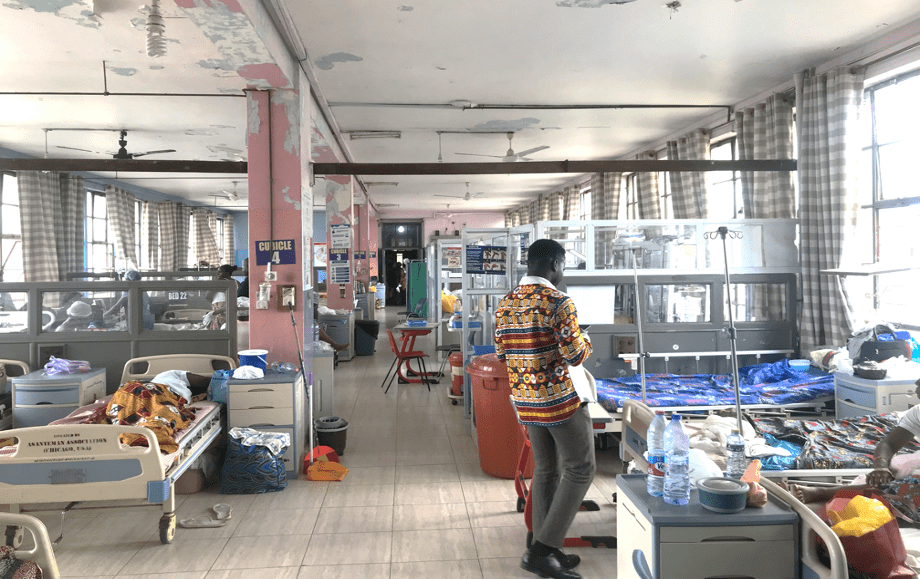The Heal Komfo Anokye Project
- Home
- About
The Asantehene 25th Anniversary Legacy Projects
The Asantehene’s 25th Anniversary Legacy Projects are a transformative initiative aimed at creating lasting impact in the Ashanti region and beyond, honouring the rich cultural heritage of the Asante people, and providing essential infrastructure and services for the health and wellbeing of the community.

About HeKAP
The purpose of this proposal is to address the urgent need for infrastructural improvement in Komfo Anokye Teaching Hospital (KATH), Ghana’s second-largest teaching hospital which receives referrals from 12 out of the 16 Regions of Ghana. Despite its reputation for providing quality and affordable healthcare services and conducting groundbreaking research, KATH faces serious infrastructural challenges that affect service delivery to patients, visitors, and staff.
The Asantehene 25th Anniversary Legacy Projects, as part of its impact mission, is mobilising resources and funding to implement a comprehensive solution that will improve Komfo Anokye Teaching Hospital’s (KATH) infrastructure and ensure that it continues to provide a more functional and efficient hospital environment that promotes healing, comfort, and safety for the people of Ashanti Region and beyond.
Specifically, the project seeks to:
-
Upgrade the infrastructure and facilities of the hospital wards to meet modern standards and improve the overall patient experience. This includes improving the lighting, ventilation, and sanitation systems, as well as installing modern medical equipment and technology.
-
Enhance the privacy and confidentiality of patients by providing well-partitioned areas that allow for proper isolation and infection prevention and control.
-
Increase the efficiency of the hospital wards to improve the flow of patients and staff within the hospital.
-
Create a more welcoming and comfortable environment for patients and visitors by improving the aesthetics and ambience of the hospital wards.
-
Improve the working conditions and safety of healthcare staff by providing adequate equipment, storage and rest areas.

Present Situation Assessment
The state of the hospital wards at Komfo Anokye Teaching Hospital is a heartbreaking and sobering reality. Patients who come seeking medical care are met with a dilapidated and hazardous environment that offers little comfort, safety, or hope. Rusty and creaky beds, cracked and chipped floors, broken windows, and peeling paints are just a few of the distressing sights that greet patients and their families.
The talented team behind our great project
The project team is comprised of highly experienced professionals in their respective fields, dedicated to bringing positive change to the Komfo Anokye Teaching Hospital.
The team is made up of engineers, architects, project managers, and consultants, all with a shared passion for improving healthcare infrastructure and patient care.
With combined expertise in healthcare facility design, construction, and management, the team is well-equipped to deliver a successful renovation project for the hospital.

SAMUEL ADU BOAKYE
Chairnan

SAMUEL ADU BOAKYE
Chairnan
- Phone:+233 20 551 6330
- Email:info@healkomfoanokye.org

PROF. DR. DR. OTCHERE ADDAI-MENSAH
Member & CEO, KATH

PROF. DR. DR. OTCHERE ADDAI-MENSAH
Member & CEO, KATH
- Phone:+233 20 551 6330
- Email:info@healkomfoanokye.org

NANA PROF OHENEBA BOACHIE-ADJEI WOAHENE II
Member
- Phone:+233 20 551 6330
- Email:info@healkomfoanokye.org

ARC. KOJO DARKO-ASANTE, AGIA
Member

ARC. KOJO DARKO-ASANTE, AGIA
Member
- Phone:+233 20 551 6330
- Email:info@healkomfoanokye.org

NANA YIM AWERE ABABIO (MR. ELVIS KUSI)
Member
- Phone:+233 20 551 6330
- Email:info@healkomfoanokye.org

KWAME FRIMPONG
Member

KWAME FRIMPONG
Member
- Phone:+233 20 551 6330
- Email:info@healkomfoanokye.org

EMMANUEL OSEI SARFO
Member

EMMANUEL OSEI SARFO
Member
- Phone:+233 20 551 6330
- Email:info@healkomfoanokye.org

JERRY OWUSU-ANSAH
Member

JERRY OWUSU-ANSAH
Member
- Phone:+233 20 551 6330
- Email:info@healkomfoanokye.org

MARILYN MAWUSI AZUMAH
Snr. Nursing Officer, KATH

MARILYN MAWUSI AZUMAH
Snr. Nursing Officer, KATH
- Phone:+233 20 551 6330
- Email:info@healkomfoanokye.org

FREDERICK OPPONG
Member

FREDERICK OPPONG
Member
- Phone:+233 20 551 6330
- Email:info@healkomfoanokye.org

OHENE MENSAH BOAKYE
Member

OHENE MENSAH BOAKYE
Member
- Phone:+233 20 551 6330
- Email:info@healkomfoanokye.org

MAXWELL OPOKU-AGYEMANG, ESQ
Snr. Nursing Officer, KATH

MAXWELL OPOKU-AGYEMANG, ESQ
Snr. Nursing Officer, KATH
- Phone:+233 20 551 6330
- Email:info@healkomfoanokye.org

ABENA KYEI BOAKYE
Member

ABENA KYEI BOAKYE
Member
- Phone:+233 20 551 6330
- Email:info@healkomfoanokye.org
Our evolutionary path
Tracing our journey from grassroots beginnings to national impact, see how we've evolved to create sustainable change KATH.
Launch
Our humble beginnings started with a vision to address pressing issues at KATH
10th November 2023
Komfo Anokye Teaching Hospital, Kumasi
Renovation
With growing support, we started the renovation works at various wards.
1st May, 2024
Komfo Anokye Teaching Hospital, Kumasi
Inspection
The Asantehene, Otumfuo Osei Tutu II inspects the progress of work on the Heal Komfo Anokye project after touring Phase One, which is now 95% complete.
31st January, 2025
Komfo Anokye Teaching Hospital, Kumasi
Training
Staff receive training on newly installed medical equipment in Wards A3, A4 & A5.
Feburary, 2025 - Present
Komfo Anokye Teaching Hospital, Kumasi
Get involved
Join thousands of others across the country
Giving your time means helping to give those most vulnerable a chance at the future they deserve.


